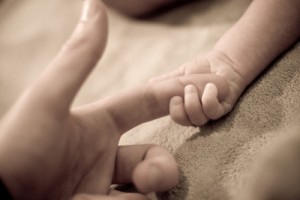
To Share or Not To Share (the Family Bed)
Some of the most common questions posed to parents of newborns, particularly by other parents, relate to sleeping patterns. Choices around sleep can be personal and sometimes controversial.
In western cultures, it is normal to put infants in a different room. But in much of the rest of the world, the baby either sleeps with parents (bed-sharing) or in close proximity to the parent (co-sleeping).
These differing traditions often present a dilemma to parents in western societies who hear opposing points of view when seeking advice.
James McKenna, professor of anthropology at the University of Notre Dame considers that despite the dominant view (no bed-sharing), parents increasingly are opting for co-sleeping or bed-sharing. In fact, half of U.S. parents with infants, bed-share with their children either during at least part of the night.
This is especially true for breastfeeding mothers as co-sleeping can make night-time feeding easier to manage. It is thought by many that co-sleeping while breastfeeding results in the mother being more in-tune with the infant’s immediate hunger needs and as a result, the infant quickly learns that their needs can be satisfied. This contributes to the development of secure attachment.
According to the American Academy of Paediatrics and Academy of Breastfeeding Medicine, mothers should sleep in close proximity to their baby not only to help facilitate breastfeeding but also to improve the survival rate of the developing infant.
McKenna also indicates that from an anthropological viewpoint the proximity and sensory touch associated with bed-sharing induces positive behavioural and physiological changes in the infant. Studies have found long-term benefits of bed-sharing or co-sleeping. For example, children who bed-shared were found to have less anxiety and a higher level of comfort in social situations later on.
Traditional western medical views on bed-sharing tend to be rather negative. Based on the Joint Statement on Safe Sleep: Preventing Sudden Infant Deaths in Canada, the main reason cited is the threat of sudden infant death syndrome (SIDS).
The Joint statement defines SIDS as, “the sudden death of an infant less than one year of age, which remains unexplained after a thorough case investigation, including the performance of a complete autopsy, an examination of the death scene, and a review of the clinical history.”
Because it is difficult to distinguish specific causes of death that occurred during sleep, in many SIDS cases the cause may be cited as “unintentional suffocation due to overlaying,” which may be used to discourage bed-sharing.
Yet in many of the studies where infant deaths are discussed, parental smoking, alcohol consumption and unsafe sleeping practices are often major factors, as opposed to bed-sharing per se. Understanding preventative measures and safe sleeping practices can help reduce the incidence of SIDS.
Further, some research has found a strong link between breastfeeding and lowered risk of SIDS. Fern Hauck of the University of Virginia reviewed 18 studies that looked at the relationship between these two variables and found that babies exclusively breastfed had a 70% lower risk of SIDS, and the risk is lowered further, the longer breastfeeding continues. Researchers attribute this lowered risk to infants being able to awaken more easily, reducing the risk of sudden death.
Daniel Flanders, paediatrician at North York General Hospital in Toronto, states that as a physician he follows the guidelines for the prevention of SIDS, but feels that strong recommendations against bed-sharing undermines parental choice on how to raise one’s child. He notes that in non-westernized communities bed-sharing is often a major part of the cultural practice of child rearing, and therefore his approach is to present the most relevant and up-to-date information available so the parent can make an informed decision.
There are several measures one can take to reduce the risks associated with bed-sharing. One of the most important things for the baby’s safe sleep is ensuring that the surface the infant sleeps on is firm, smooth and flat. Sheets should be tucked and never loose, whether the child sleeps with the parents, in a sidecar or in the crib.
If parents choose to bed-share there should be ample space for all, with both parents agreeing to the arrangement. The bed should not be shared with multiple children, especially if one or more are slightly older. Also, if the bed is raised off the floor there should be a mesh guardrail around the bed to prevent the baby from falling over. If the bed is against the wall, parents should ensure that there is no gap between the bed and the wall at all times.
Although bed-sharing is often discouraged by many in the medical community due to its association with an increased risk of SIDS, this does not mean that the practice is without benefit. Done safely, bed-sharing and co-sleeping offer unique opportunities for the development of closeness between parent and child.
Parents must choose the arrangement that works best for them and their families. For more information: Safe Sleeping Practices for Infants
-Saqina Abedi, Contributing Writer





